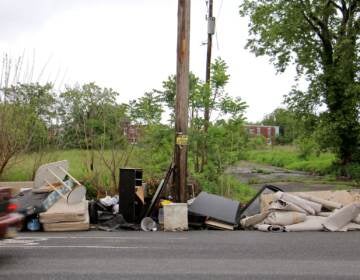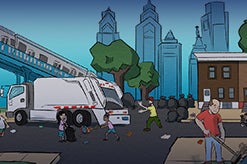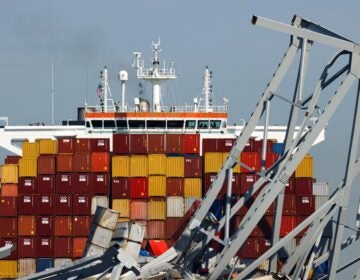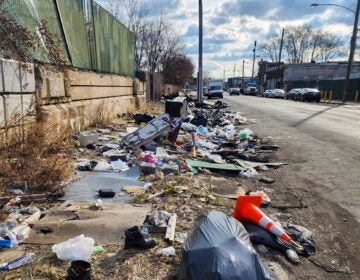Sanitation solutions: How giving people trash bins made Baltimore cleaner
Baltimore’s green bin program shows there are relatively simple steps cities can take to tangibly improve the cleanliness of neighborhoods.
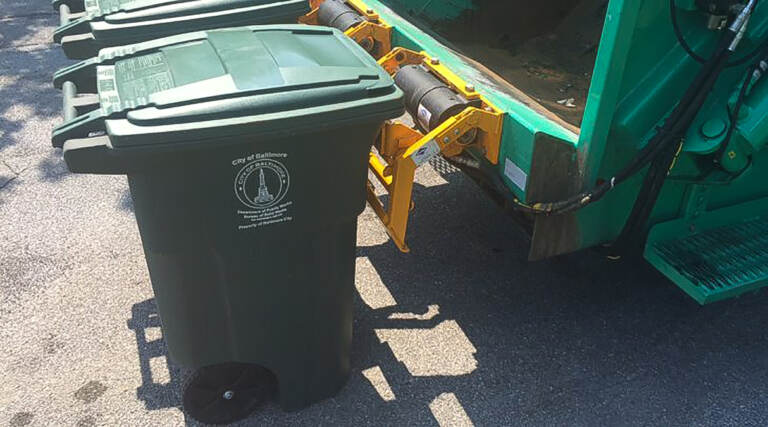
A Baltimore city trash bin. (City of Baltimore)
When then-president Donald Trump went on the attack against Rep. Elijah Cummings in 2019, he made an oddly specific claim about the late congressman’s Baltimore-area district: that it was “a disgusting, rat and rodent infested mess.”
House Speaker and Baltimore native Nancy Pelosi rose to Cummings’ defense, while other observers noted that rat problems were actually worse on Trump’s home turf of Washington, D.C. In fact, while Baltimore does have a long history of rodent infestations, rat complaints by residents had fallen sharply over the previous four years, reportedly plummeting 47% from 2015 to 2018.
According to local officials and residents, much of the drop could be credited to a policy decision by Baltimore’s municipal government. In 2016, the city spent $9 million to buy its residents 200,000 big green trash cans with lids and wheels, and half a million dollars more to retrofit trash trucks with automated lifting arms.
The move was prompted not only by escalating numbers of rats, but also by injuries to sanitation workers from lifting trash bags all day and trash blowing out of containers, said Matthew Garbark, deputy director of the Department of Public Works.
“On a windy, blustery day, if a bag had been ripped open or a can had lost its lid, it was not uncommon to see all sorts of stuff, papers and other trash and all, blown throughout the alleys,” he said.
Simply giving people new bins “worked extremely well. We saw a lot less litter and a lot less rat population as a result of that,” he said. A reduction in injuries also cut the city’s spending on worker’s compensation claims.
The cans didn’t solve all of Baltimore’s problems. Some residents don’t have a good place to store them, or think they’re ugly or smelly, Garbark said. Bins break or are stolen. Replacing them has been hampered by pandemic-related supply issues. There’s even been something of a rat resurgence as residents have been eating at home more over the past year and generating more curbside trash.
Like Philadelphia and other big cities, Baltimore also has other trash challenges, like illegal dumping and a low recycling rate. But its green bin program and other initiatives show there are relatively simple steps municipalities can take to tangibly improve the cleanliness of their neighborhoods, provided they have sufficient funding and political will.
Terrill Haigler, aka “Ya Fav Trashman,” a former Philadelphia sanitation worker who has recently become a prominent activist on trash issues, said it has been clear for a long time that his city should follow Baltimore and many other places in switching to a system of standardized trash cans and semi-automated collection trucks.
“I’ve been singing that since I started,” said Haigler, who worked for Philadelphia’s Streets Department from December 2019 to February 2021. “The sanitation worker just has to wheel the can to the truck, tip it with a lever, and wheel it back. Cuts down on injuries, cuts down on stuff getting in the street, but also regulates the trash. It makes everyone have to fit everything into the blue can and the black can, or whatever color they’ll be.”
Haigler, a frequent critic of the Streets Department, has been trying to address trash problems himself by creating Glitter, an app that allows donors to sponsor blocks for trash collection, creating jobs for Philadelphia residents and cleaner streets, he hopes. He’s also preparing to launch a waste hauling service for construction sites — a private service he hopes will encourage builders to remove trash rather than dump it illegally on neighborhood streets. But he said it will take official action by city leaders to make the large-scale changes needed to truly clean up Philadelphia.
“Whoever’s in charge is going to ignite the change,” Haigler said. “If whoever’s in charge is okay with things being the way that they are, they’re going to stay this way.”
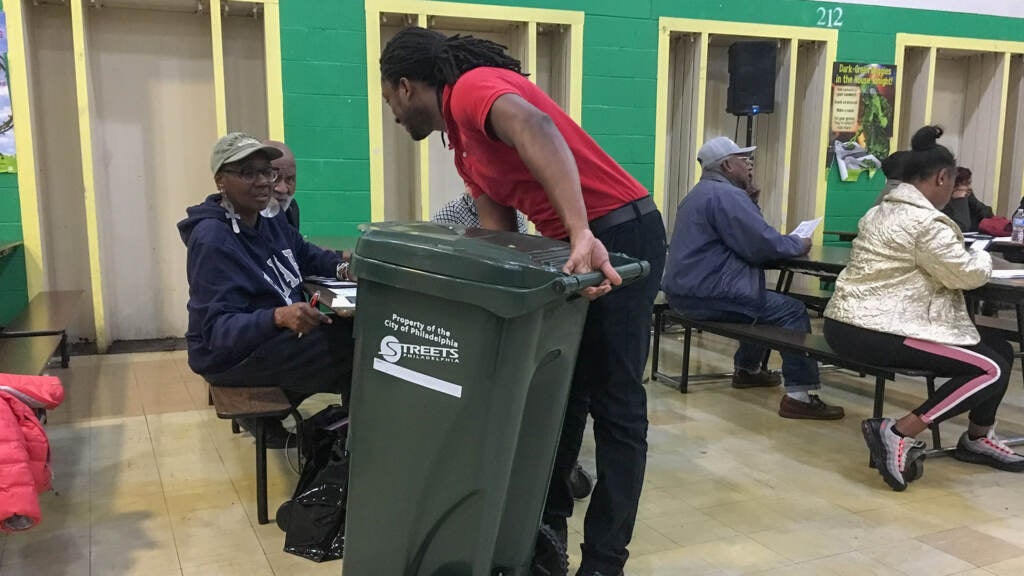
A small start
While Philadelphia is not distributing trash bins citywide, Baltimore’s example did inspire a small pilot program.
After Philadelphia Streets Commissioner Carlton Williams visited both Baltimore and Norristown, Pa., which also provides bins to households, he decided to experiment with the model. In 2018, the city launched PhilaCan in a section of North Philadelphia with major litter problems, west of Broad Street near Temple University.
The $150,000 pilot, funded by a state grant, distributed bins only on blocks where 75% of households signed up and agreed to maintain the cans and keep them outside. Residents on close to 100 blocks expressed interest but only 26 blocks got the required signatures and joined the program, said Kyle Lewis, the Street Department’s recycling program director. The city provided about 1,400 lidded trash cans and 1,400 recycling bins for homes on those blocks.
“We wanted to address some of the challenges we were getting from our residents with regard to their trash storage,” Lewis said. “If you have the whole block, or at least 75% of the neighbors that sign on, it is more likely the whole block will benefit from it. It’s a way to clean up blocks at a time, and therefore neighborhoods at a time.”
As in Baltimore, some residents objected to the aesthetics of a large bin in front of their house. Lewis said some were concerned it would be used as a neighborhood trash can and attract litter. More recently, the pandemic kept the department from sending out canvassers to discuss concerns with residents and encourage more blocks to join, she said.
“Paradigm shifts are often hard for people to accept. A lot of people need to be reassured when it is time to enact a dramatic shift, and some people would consider this as such,” Lewis said. “Buy-in has been a challenge, though it has proven successful for many of the blocks involved. Their blocks are cleaner.”
“In a lot of ways, people in Philadelphia need to see the beauty of their neighborhood. It’s one thing to clean up in front of your house, but when you see your whole block clean, it’s more encouragement to keep the whole block clean. It can foster pride, and we want people to have pride in the city. We want people to care about the city enough not to dump on it,” she said.
Now that pandemic-related pressures have eased somewhat, the department is gearing up to expand PhilaCan to other neighborhoods, Lewis said. The city has bins to distribute, but will need additional funding if it finds significant demand, she said.
Williams said in 2018 that he wanted to roll out PhilaCan citywide, but Lewis said budgetary constraints mean it is unlikely the city will ever provide cans to all of its 590,000 potentially eligible households. She also said the program may not be cost-effective on all blocks, for example in neighborhoods where homes already have ample trash storage space.
Up next, recycling bins
As Baltimore continues to implement its trash bin program, Garbark noted that his department is also pursuing other waste management improvements. The city’s Less Waste, Better Baltimore master plan, finalized in July 2020, lays out a timeline of recommended initiatives to reduce food waste, encourage composting, and substantially expand recycling.
Garbark said a looming lack of space to dispose of trash is driving the city to act.
“Obviously, there’s sustainability and environmental protection and all, but one of the real big overarching issues is that we have a landfill that’s filling up. We’re working on an expansion of it right now. It’s going to take about two to three more years for construction. But once we hit that capacity, there is no other option for landfilling,” he said. “So it’s absolutely critical that we find every way to divert waste away from the landfill.”
Officials are also under pressure from environmental-justice activists to stop sending waste to an incinerator in South Baltimore that is the city’s biggest source of air pollution. Last year, when the incinerator contract was renewed for another decade, then-mayor Bernard Young said he understood the opposition, “but we have to have somewhere to send our trash,” the Baltimore Sun reported.
Garbark said the low cost and convenience of throwing out trash has actually contributed to the city’s low recycling rate of about 24%, well below its state-mandated goal of 35% and average for all Maryland counties of 45%. To make recycling just as easy, last month Baltimore started distributing 190,000 rolling, lidded recycling carts for residents to use along with their city-issued garbage bins.
The recycling bins will cost $9.5 million, with $3 million coming from The Recycling Partnership, a nonprofit funded by corporations that make and sell plastic products. The $3 million includes $1.65 million from the beverage industry and a donation from Dow of plastic resin for the carts. The city will cover its share in part with $3 million in zero-interest financing from Closed Loop Partners’ Infrastructure Fund.
Other steps the city is taking to improve its trash situation include quicker responses to reports of illegal dumping and, as in Philadelphia, a new plastic bag ban that started this month. Baltimore also organizes community cleanup events and has launched a pilot program that hires residents to clean streets as a pathway toward a job at the DPW.
But Garbark noted that city workers can’t be everywhere all the time, and many initiatives depend on residents’ cooperation to have a real impact.
“Those solutions won’t last if we don’t get buy-in, support and encouragement from communities. They need to look out: if they see people dumping, if they see their neighbors doing stuff, they need to step up, they need to call them out on it,” he said. “They need to really take ownership of their communities and clean them up, and bring us in to help with that.”
This article is part of Sanitation Solutions, a series supported by the Solutions Journalism Network. Join I Love Thy Hood’s Mathew George and others for a virtual discussion on Wednesday about how to solve Philadelphia’s dirty streets problem.

Subscribe to PlanPhilly
WHYY is your source for fact-based, in-depth journalism and information. As a nonprofit organization, we rely on financial support from readers like you. Please give today.




